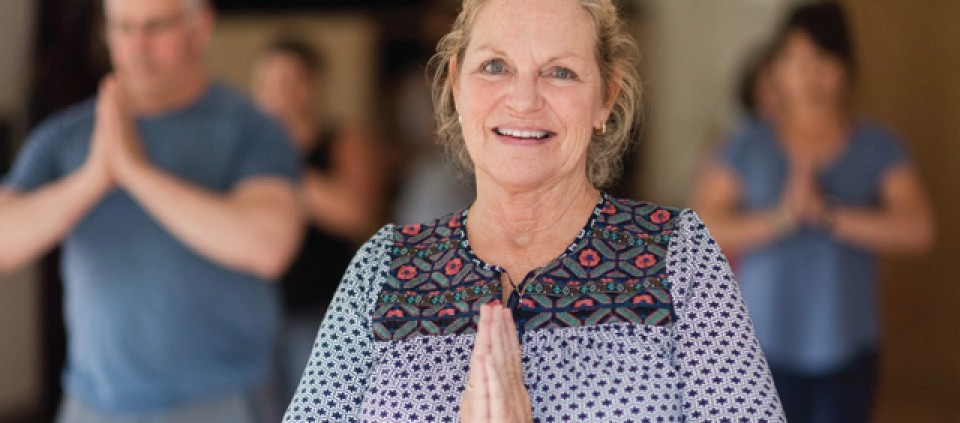The Vata Stage of Life: 10 Tips for Aging Better with Ayurveda

We are a society that worships youth. We spend more than $50 billion globally on anti-aging products in the vain hope that they can help us beat the clock. And as the number of older people increases—predicted to reach more than a quarter of the population by 2050—we can expect a corresponding increase in age discrimination.
In a world that wants to sell us Botox, facelifts, and miracle cream, and considers us irrelevant once the bloom is off the rose, how can we take back the wisdom years and celebrate aging?
What Is Vata?
The classical Ayurveda texts delineate three stages of life, broadly described as young age, middle age, and old age. These can be translated as the kapha stage of life (young), the pitta stage of life (middle), and the vata stage of life (old age).
Vata is one of the three doshas, or biological-elemental compounds, which works in conjunction with pitta and kapha to maintain the functions of the body-mind complex. Vata is a substance-less substance comprised of space and wind (also called air and ether), and governs all the movements of the body. Its qualities are dry, light, cold, subtle, and mobile; seasonally, vata rules the fall, winter, and cold climates.
The classical Ayurvedic text known as the Charaka Samhita describes the vata phase of life as our final act, starting around age 50 or 60. As the vata in our constitution increases, we experience a range of physical and mental changes, ranging from drier skin to declining cognitive abilities. Yet the vata stage can also bring softening and wisdom.
The Wisdom of the Vata Years
I see such depth of wisdom in my family and teachers as they age through the vata stage. My dad offers me some of the richest wisdom of my life. My yoga teacher Leeann is a continual inspiration for me in how to overcome difficulties in life with grace and vulnerability. My mom cares day in and day out for my aging grandmother, taking in lessons on how she wants to age and live fully.
Now that I’m in my 40s, I see them as role models for the vata stage. As I notice lines on my face and gray hair on my head, I’m grateful that I have been able to study and practice Ayurveda for the last decade, and learn that beauty, radiance, and joy comes from the inside and shines outward.
10 Ayurvedic Tips for Aging
Here are some ways to incorporate Ayurveda into your life as you journey through the vata stage.
1. Put oil on everything. Ayurveda loves oil. We put it on everything—on our food and our bodies. I use a brahmi-coconut oil on my face as a moisturizer. Brahmi is an Ayurvedic herb that supports mental clarity and increases collagen in the skin; you can eat brahmi-coconut oil on your food as well as using it as an all-natural facial moisturizer. Because it’s cold most of the year in New England, I favor warming and nourishing oils for daily self-massage, like Banyan Botanicals’ Vata Massage Oil or Ashwaghanda-Bala oil.
2. Eat more cooked foods. Because we get colder and drier as we age, it’s important to favor cooked foods that generate internal warmth—soups, stews, steamed veggies, and roasted veggies. Add ghee or olive oil as part of the recipe, or drizzle it on your rice and kitchari.
3. Hydrate. The classical texts suggest more water for a vata time or type, because of the dryness that is present during vata stage of life. Drink six to eight glasses per day, and if you want to get more out of your water, try cooking it!
4. Stay mobile. We want to keep the fluid in our joints warm and lubricated. This can mean regular walks, yoga or stretches daily, or a series of joint rotations called dasha chalana. Maintaining our strength and balance is essential, in part to avoid falls. When exercising, make sure you have supports nearby, like the wall, a chair, and blocks. My favorite exercise is a long walk with a good friend; it nourishes my heart and body—true at any age, I think.
5. Meditate. The vata stage of life is a time to lean more into meditation. For many, the demands of work and family are diminishing, creating more space and time to explore the rich inner world. In traditional Indian culture, the ages between 50 and 100 are described as the “forest-dwelling” and “renunciate” stages of life. In the forest-dwelling stage, from ages 50 to 75, we are still active in the world, working or taking care of grandkids, but can bring more meditation practice into our routine. Between 75 and 100, we move toward renouncing the material world, living simply, and spending most of our time in meditation. For example, my parents, who are in their 70s, have a smaller house, are retired, and don’t have kids in the household. They are more involved with their church and also care for my grandma. They are both in the world and devoting more time to spiritual exploration. Even 15 minutes of meditation a day can help us slow down, breathe more deeply, and generate gratitude for this gift of living.
6. Stay connected to community. Because we spend most of our lives working and developing work relationships, retirement can bring a sense of losing our community, which can create loneliness and lead to depression (read Johan Hari’s Lost Connections for more on this topic). Find ways to get involved with a like-minded community—go to yoga classes in your neighborhood; connect with book groups or other established groups; volunteer in schools, community centers, or nursing homes.
7. Learn something new. Take a class. Do puzzles. Read about something you don’t know about. You are never too old to be a student; we have lots of Baby Boomers in our trainings here at Kripalu. Current science and Ayurveda recognize that there is a normal decline in cognitive function (although yoga can help slow that decline). According to Harvard researchers, there are lots of things to do to keep the brain sharp.
8. Make lunch your largest meal. According to Ayurveda, lunch should be the biggest meal of your day—which is easier if you don’t have a nine-to-five work schedule. This way, you have more time to digest than you do at night, and a hearty lunch provides energy for your afternoon. After eating, lie on your left side for 10 minutes, and then take a 15-minute walk to further enhance digestion.
9. Get to bed early. Ayurveda and some sleep researchers maintain that we get the most restorative sleep before 2:00 am. Every hour of sleep before midnight is worth two after midnight, because we get the most restorative non-REM sleep during those earlier hours. Another good reason to get to bed early: Morning is the ideal time for meditation.
10. Cultivate gratitude. My aging family and friends have more gratitude, and have let go of hurts from the past. I appreciate this because my mom has a nice big gap in her memory about all the things I did in high school that were not my finest moments! She is grateful for her healthy kids and proud of us for how we are living our lives. Essentially, at this stage in life, time is too short to focus on the negative.
Erin Casperson, Lead Kripalu Faculty and Director of the Kripalu School of Ayurveda, is passionate about sharing how the ancient practices of Ayurveda can be applied to modern-day living.
Full Bio and Programs
